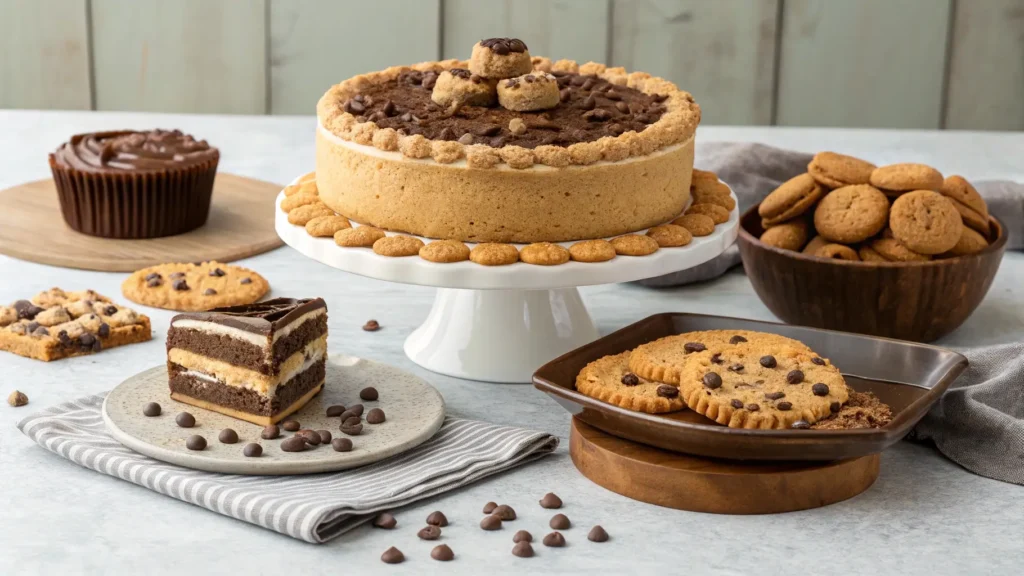What is Cookie Dough?
Cookie dough is the uncooked mixture of ingredients that will eventually become cookies. It typically consists of flour, butter, sugar, eggs, and flavorings such as vanilla. The dough is mixed together until it reaches a smooth, soft consistency. You can add various extras, like chocolate chips, nuts, or dried fruits, to customize the dough to your taste.
However, some people enjoy eating it raw, as it has a sweet, comforting flavor and smooth texture. In recent years, cookie dough has gained popularity in desserts like ice cream or as a standalone treat. While rawdough does contain eggs, which pose a slight risk of foodborne illness, many recipes now use egg-free alternatives to make it safer to eat raw.

Table of contents
The Origins and History
Cookie dough has an interesting history that dates back centuries. Its origins trace to early baking practices, where simple doughs made from flour, sugar, and fat were used to create baked goods. However, the modern cookie dough we know today started taking shape in the 1930s. At this time, chocolate chip cookies were invented by Ruth Wakefield, who added chunks of chocolate to her dough by accident. This discovery quickly became a hit, making chocolate chip cookie dough a household favorite.
In the 1980s, pre-made cookie dough became widely available, allowing people to easily bake cookies without measuring or mixing ingredients. Today, cookie dough is enjoyed in many forms, from raw dough snacks to gourmet creations in restaurants. Cookie dough’s history is a reminder of how a simple mixture can evolve into a beloved treat over time.
Types of Cookie Dough
There are many types of cookie dough, each offering unique flavors and textures. The classic version, often referred to as chocolate chip cookie dough, remains the most popular. It typically contains flour, butter, sugar, eggs, and chocolate chips. This type of dough is easy to prepare and can be enjoyed in various forms, from chewy to crispy, depending on the baking time.
Another beloved variation is peanut butter cookie dough. This dough is made with creamy peanut butter, which gives it a rich, nutty flavor. Peanut butter dough has a soft, tender texture and is perfect for those who love a sweet and savory combination.
For a more sophisticated twist, gourmet cookie dough includes unique ingredients like toffee, macadamia nuts, or exotic spices. These doughs offer an elevated experience with more complex flavors. They may include high-quality chocolate or even sea salt for a balanced taste.
In recent years, egg-free dough has become popular due to its safety when eaten raw. This dough replaces eggs with alternative binders like applesauce or flaxseed. Additionally, some people prefer gluten-free dough, which uses gluten-free flour blends to create dough that caters to dietary restrictions.
As you can see, cookie dough has evolved far beyond the traditional chocolate chip variety. Whether you’re baking classic cookies or experimenting with gourmet versions, there is a dough for every taste and occasion.

How to Make Cookie Dough from Scratch
Making cookie dough from scratch is simple and enjoyable. First, gather all your ingredients: flour, sugar, butter, eggs, vanilla extract, and a pinch of salt. Begin by beating the butter and sugar together in a large bowl until smooth and creamy. Use a hand mixer or stand mixer to beat them until the mixture becomes light and fluffy. This step is essential for creating a soft, chewy texture in your dough.
Next, incorporate the eggs one by one, ensuring each is fully blended before adding the next. Then, stir in the vanilla extract for flavor. In another bowl, combine the flour, baking soda, and salt by whisking them together. Gradually add the dry ingredients to the wet mixture, stirring until just combined. Be careful not to overmix, as this can result in tough dough.
Once your cookie dough is ready, it’s time to add mix-ins like chocolate chips, nuts, or dried fruit. Fold them in gently using a spatula, ensuring they are evenly distributed throughout the dough.
Now, you can shape your dough into small balls using a cookie scoop or spoon. Arrange the dough balls on a baking sheet, leaving enough space between them to allow for spreading. If you prefer, Chill the dough for about 30 minutes before baking to achieve a firmer texture. This step helps the dough maintain its shape and reduces spreading.
Finally, bake the cookies in a preheated oven at 350°F (175°C) for 8 to 12 minutes, depending on how soft or crispy you prefer your cookies. Allow the cookies to cool on a wire rack before serving.
If you’re looking for a flavorful addition to your cookie dough, consider adding vanilla paste. You can learn how to make the best vanilla paste in our detailed recipe here.
Store-Bought vs. Homemade Cookie Dough: Which is Better?
There are two primary choices for cookie dough: pre-made from the store or freshly made at home. Both have their advantages, but which one is better depends on your needs and preferences.
Homemade cookie dough allows for full control over the ingredients. You can choose high-quality butter, adjust the sugar levels, or add any extras like chocolate chips or nuts. Additionally, making your own dough is a fun activity that lets you customize the flavor and texture to your liking. However, it does take more time and effort to prepare from scratch.
On the other hand, store-bought cookie dough offers convenience. It saves you time since it’s pre-mixed and ready to bake. This can be particularly helpful when you’re in a rush or don’t have the ingredients on hand. The dough also comes in a variety of flavors, from classic chocolate chip to more gourmet options. However, some store-bought versions may contain preservatives or artificial ingredients, which could be a downside for those who prefer all-natural products.
Ultimately, the choice between homemade and store-bought cookie dough depends on your priorities. If you value customization and quality, homemade is the way to go. If convenience is more important, store-bought dough might be your best option.
Is Raw Cookie Dough Safe to Eat? Understanding the Risks
Eating raw cookie dough is a tempting treat, but it’s important to understand the potential risks. The two main concerns are raw eggs and uncooked flour. Raw eggs might harbor harmful bacteria like Salmonella, which can lead to foodborne illnesses. Although the risk is low, it is still present, especially in homemade dough.
Another concern is the uncooked flour in cookie dough. Flour is a raw agricultural product, which means it can be contaminated with harmful bacteria like E. coli. These bacteria are usually killed during the baking process, but they remain in the dough until it’s cooked.
To reduce these risks, many recipes now use egg-free dough. This version replaces raw eggs with ingredients like applesauce or flaxseed.
If you prefer to eat raw dough, look for commercially produced cookie dough that is specifically labeled as safe to eat raw. These products are made with pasteurized eggs and heat-treated flour, ensuring they are free from harmful bacteria.
In summary, while eating raw cookie dough can be risky, there are safer alternatives available. If you choose to indulge, be sure to take precautions to minimize the health risks.
Tips and Tricks
Achieving the perfect cookie dough is both an art and a science. Understanding the role of each ingredient can help you create the ideal dough every time. For example, the balance of butter to flour is essential in achieving the perfect texture. Too much butter will make your dough too soft, causing the cookies to spread too much while baking. On the other hand, too little butter may result in dry cookies.
When making cookie dough, the temperature of the butter also matters. Softened butter incorporates more air into the dough, leading to lighter, fluffier cookies. If the butter is too cold or too melted, it will affect the texture and consistency of your dough.
Another important factor is chilling the dough before baking. Cooling the dough allows the fats in the butter to solidify, which helps the cookies maintain their shape during baking. Chilled dough also prevents excessive spreading, giving you thicker, chewier cookies.
Additionally, the type of flour used plays a role in the texture. All-purpose flour works well for most cookie recipes, but using bread flour can result in a chewier texture due to its higher protein content.
By paying attention to these details and experimenting with your cookie dough, you can achieve the perfect balance of taste and texture.
Creative Ways to Use This Dough Beyond Cookies
Cookie dough isn’t just for baking cookies; there are many creative ways to use it in other desserts. One popular option is to bake cookie dough into cookie bars. Simply spread the dough into a baking pan and bake until golden brown. This method creates a chewy, soft treat that’s easier to serve than individual cookies.
Another fun idea is to use this dough as a crust for pies or tarts. Press the dough into the bottom of a pie dish and bake it to form a delicious base. You can fill the crust with your favorite pie filling, creating a unique twist on traditional pies.
If you enjoy ice cream, consider adding bits of cookie dough to your frozen treat. You can either freeze the dough into small chunks and stir them into homemade ice cream or buy pre-made cookie dough ice cream. It adds a rich, sweet texture and flavor.
For a savory option, this dough can be used in savory appetizers. Adding cheese and herbs to the dough creates a fun, doughy snack that pairs well with dips.
Finally, if you’re feeling adventurous, you can shape cookie dough into a variety of fun shapes and bake them into cookies, pie crusts, or even cake layers. The possibilities are endless!

FAQS
What is the secret to making good cookies?
The secret to making good cookies is using high-quality ingredients, measuring them correctly, and following the recipe. Chilling the dough before baking also helps achieve the perfect texture.
How do you make cookie dough taste better?
To make cookie dough taste better, add extra vanilla extract, use browned butter for a richer flavor, or incorporate a pinch of sea salt to balance the sweetness.
What are the 15 common mistakes in making cookie dough?
Not measuring ingredients properly
Overmixing the dough
Using cold butter instead of softened
Using the wrong flour
Skipping the chilling step
Not using enough salt
Using stale ingredients
Overbaking the cookies
Not testing your oven temperature
Using expired baking soda
Not spacing cookies properly on the baking sheet
Adding too many mix-ins
Using too much sugar
Baking dough that’s too warm
Using ungreased baking sheets
Why do you put vinegar in cookie dough?
Vinegar is added to cookie dough to activate the baking soda, helping the cookies rise and become soft. It also helps to balance the sweetness of the dough and improve the overall flavor.
Healthier Alternatives to Cookie Dough
If you’re looking for healthier alternatives to traditional cookie dough, there are several options that can satisfy your cravings while offering a nutritional boost. One popular choice is to use whole wheat flour instead of all-purpose flour. This adds more fiber and nutrients to your dough, making it a healthier option without sacrificing flavor.
You can also swap refined sugar for natural sweeteners like honey, maple syrup, or coconut sugar. These alternatives offer a lower glycemic index, which helps maintain stable blood sugar levels. Additionally, using almond flour or oat flour instead of regular flour can make your dough gluten-free, catering to those with dietary restrictions.
For those who want to avoid butter, consider using healthier fat options such as coconut oil or avocado. These fats provide beneficial nutrients like healthy fats and antioxidants, making the dough more nourishing.
To increase protein content, you can add ingredients like Greek yogurt, peanut butter, or protein powder. These additions will help make your dough more filling and supportive of muscle health.
Finally, for a raw-friendly option, eggless dough made with chickpeas or black beans is an excellent choice. These legumes provide fiber and protein while maintaining the sweet and satisfying texture of traditional cookie dough.
Conclusion
Cookie dough remains a favorite treat for many reasons. First, its simple ingredients create a sweet, comforting flavor that appeals to people of all ages. Whether you enjoy it raw or baked, the dough’s versatility makes it a go-to option for quick snacks or desserts.
Another reason for its popularity is the endless variety of dough types. From classic chocolate chip to creative gourmet versions, there’s a dough for everyone’s taste. People can easily customize their dough with different mix-ins or opt for healthier alternatives without compromising on flavor.
Moreover, cookie dough brings back memories of baking with family and friends, adding to its emotional appeal. It’s a treat that connects people, making it a timeless choice for celebrations or casual moments.
Print
Cookie Dough Recipe
- Total Time: 26 minutes
- Yield: 24 cookies
Description
This easy and delicious cookie dough recipe is perfect for making cookies, pie crusts, or enjoying raw. Follow our tips for the best results!
Ingredients
- 1 cup (2 sticks) unsalted butter, softened
- 3/4 cup granulated sugar
- 3/4 cup brown sugar, packed
- 2 large eggs
- 1 teaspoon vanilla extract
- 2 1/4 cups all-purpose flour
- 1 teaspoon baking soda
- 1/2 teaspoon salt
- 2 cups chocolate chips (or other add-ins)
Instructions
- Preheat your oven to 350°F (175°C).
- In a large mixing bowl, cream together the butter, granulated sugar, and brown sugar until light and fluffy.
- Add the eggs and vanilla extract, and mix until fully combined.
- In a separate bowl, whisk together the flour, baking soda, and salt.
- Gradually add the dry ingredients to the wet ingredients and mix until combined.
- Stir in chocolate chips (or other add-ins like nuts or dried fruit).
- Drop rounded spoonfuls of dough onto a baking sheet lined with parchment paper.
- Bake for 10-12 minutes or until the edges are golden brown.
- Let the cookies cool on a wire rack.
Notes
- For chewier cookies, chill the dough before baking.
- You can use whole wheat flour for a healthier version.
- Feel free to substitute chocolate chips with your favorite add-ins like peanut butter chips, nuts, or dried fruit.
- Prep Time: 15 minutes
- Cook Time: 11 minutes
- Category: Dessert
- Method: Baking
- Cuisine: American
Nutrition
- Serving Size: 1 cookie
- Calories: 180 kcal
- Sugar: 18g
- Sodium: 60mg
- Fat: 9g
- Saturated Fat: 5g
- Unsaturated Fat: 3g
- Trans Fat: 0g
- Carbohydrates: 24g
- Fiber: 1g
- Protein: 2g
- Cholesterol: 25mg
Keywords: cookie dough, homemade cookie dough, cookie dough recipe, chocolate chip cookies, easy cookie dough, baking cookies

1 thought on “Cookie Dough: Perfect Tips for Success”